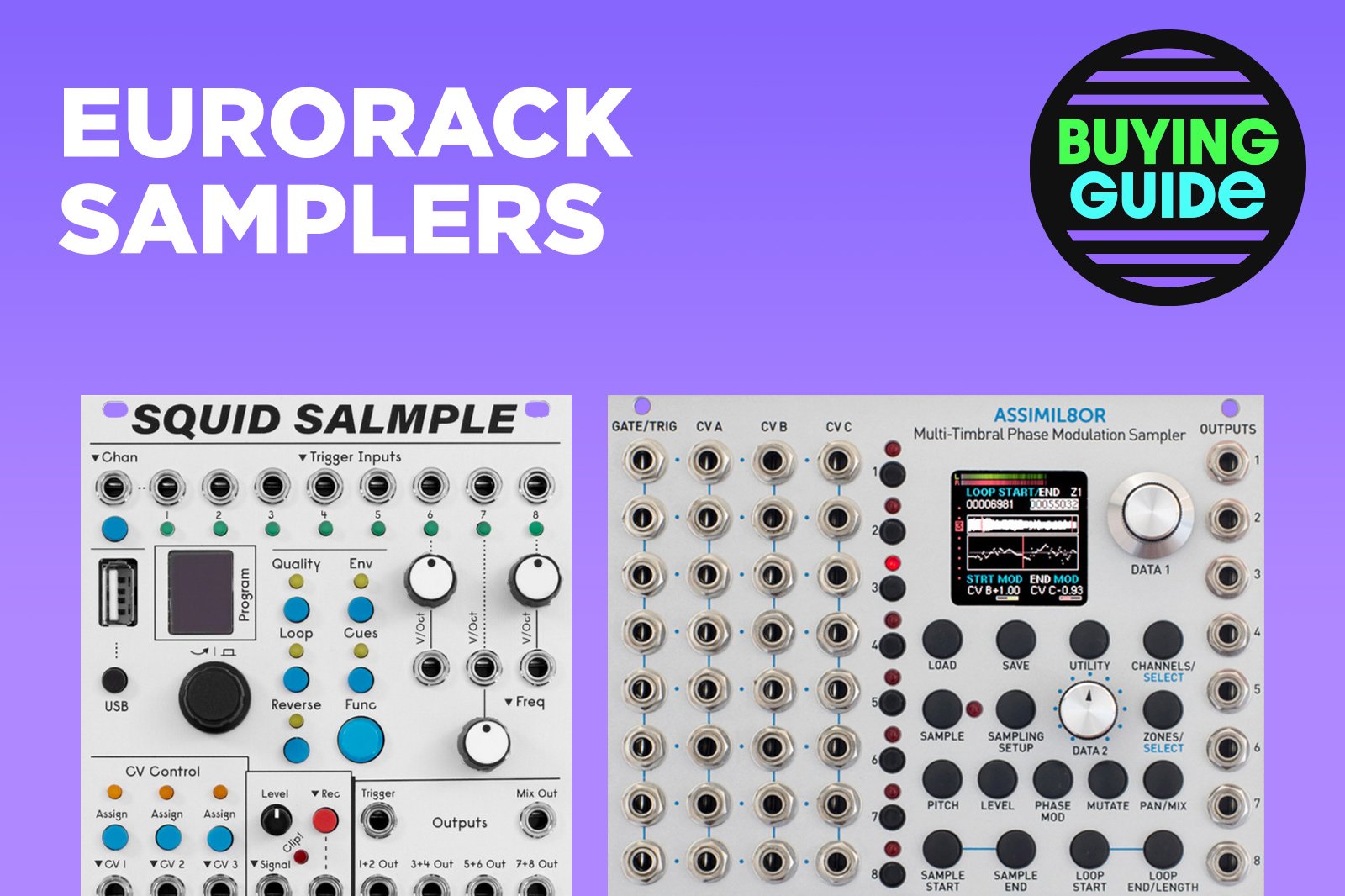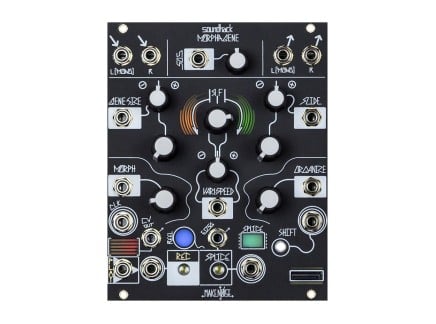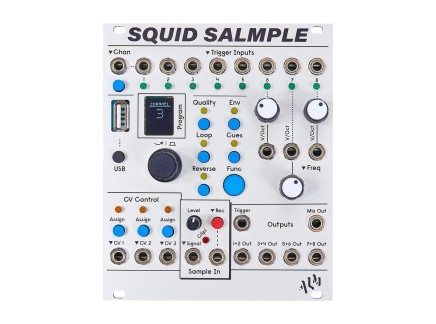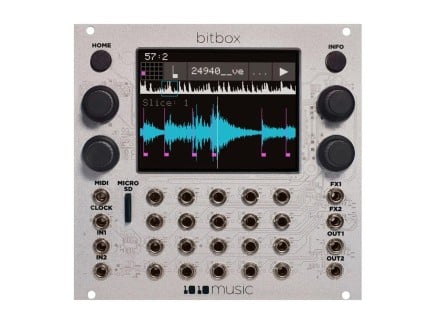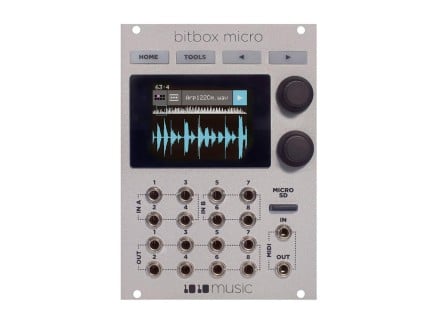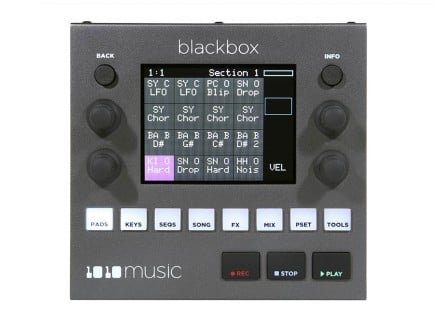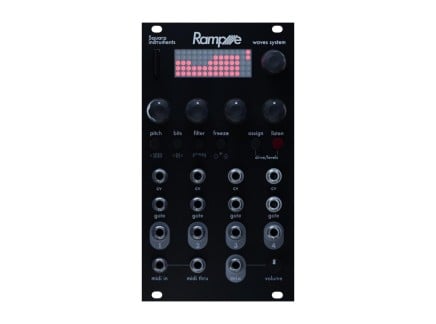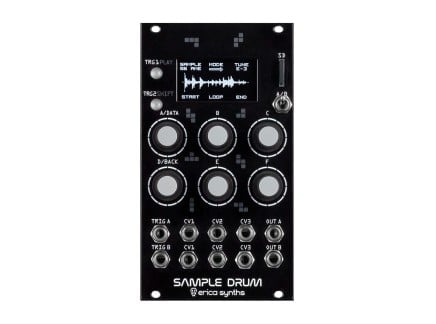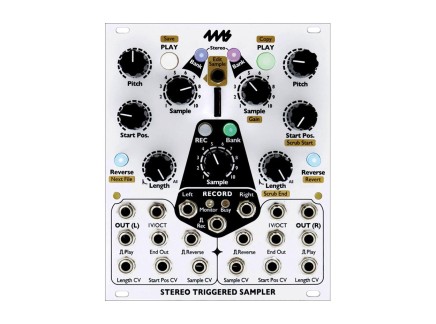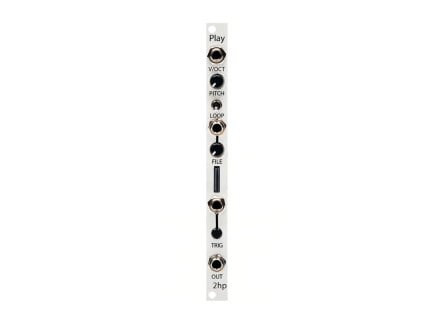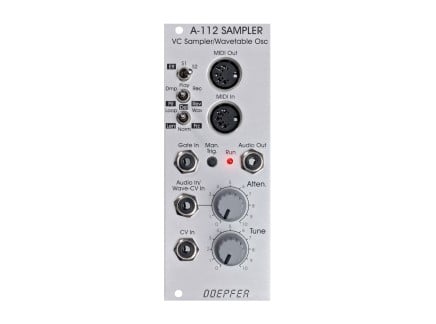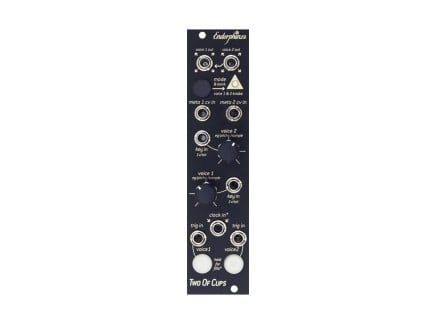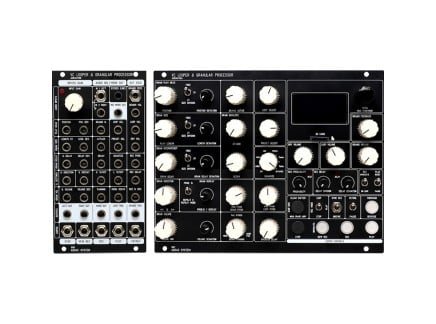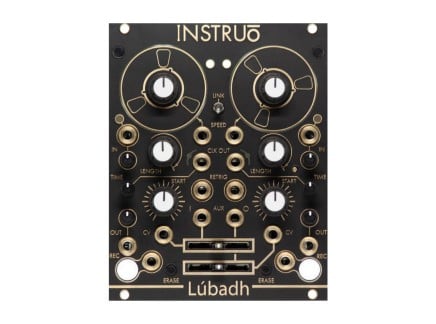Since samples can be virtually any type of recorded sound, virtually any type of Eurorack modular synthesizer setup could benefit from having a sample player/recorder. Whether you want to launch some one-shot pads while tinkering, record your playing for an arsenal of go-to sounds, or splice and mangle audio into a new beast entirely, a sampler should be an essential component of your rig.
Now over 40 years since the creation of the Fairlight CMI in the late 1970s, sampling has evolved by leaps and bounds—and has left an indelible print on the course of music. Originally bulky, temperamental, and expensive, samplers have become sleek, well-designed, and ubiquitous in modern production and live performance.
Samplers in modernity take many shapes and forms, but at its core, a sampler is simply a machine that records and plays back sound. The machine in question might also have additional sampling channels, an onboard effects section, fine-tuned editing capabilities, or even a built-in oscillator, but as long as it records and plays back sound, it’s a sampler. By that definition, we might even call this bird a sampler.
I know what you’re thinking: “The lyrebird is impressive, but it would be better with more internal storage and a 1V/Oct jack.” Ok, maybe that’s what I thought. But while impressive mimics only come with a beak and feathers, our curated guide to buying a great Eurorack sampler is filled with fun modules and enough features to keep you exploring the jungles of sonic wonder for hours to come.
Let’s get into it!
Supercharged Sample Stations
Make Noise Morphagene
Any module with the byzantine layout of a Make Noise creation can be daunting, but for those willing to learn the time-splicing secrets of the Morphagene, the rewards are great: a powerful and singular sampler/audio processor built for live performance.
According to the official manual, the Morphagene “is a next generation Tape and Microsound music module that uses Reels, Splices, and Genes to create new sounds from those that already exist.” This is a little mind-melty, but we can break the Morphagene into two essential components: a live sampler-turned-tape reel and a granular processor. Think about it like this: the Morphagene is like a tape machine with a pair of built-in magic hands that can quickly slice, stretch, and rearrange the recorded tape.
The process starts with the tape machine function and some incoming audio. Audio is recorded in virtual “reels” up to 87 seconds long, more than enough material for sonic experimentation. By activating the Sound-on-Sound function, you can record onto an existing reel with virtually limitless overdubs. Record away and pitch-shift your samples across several octaves to build dense, lilting layers at the heart of this module’s signature sound. (You can also add audio "reels" directly to the SD card via your computer—making Morphagene a great choice for integrated pre-recorded/prepared audio into your modular system.)
What makes the Morphagene singular and sought-after is its granular processing power. The Genes knob determines the size of the Gene (aka “Grain”) or the selected portion of audio; the Slide knob changes the starting point of playback within the current "splice"; and the Morph knob causes Gene replay overlap and creates new rhythms and textures. Add to all of that the possibility for live resampling, time stretching, and voltage control, and you'll quickly understand how these controls drum up the strange stutters and creepy echoes which have drawn synth fans to the Morphagene since its 2017 release.
Rossum Electro-Music Assimil8or
If you’re looking for a more intuitive experience, the Rossum Assimil8or is a powerful rig centerpiece that offers deep sampling functionality in a UX-friendly design.
As the name suggests, the Assimil8or comprises eight channels, each with an eight sample capacity and its own Gate/Trigger and Output as well as a stereo sample input and stereo mix out. In between those gates and outs are three variable CV inputs, a compact screen, and a vast-but-organized array of buttons and dials to handle all your sample morphing needs.
If you’re worried that the Assimil8or looks cool but seems menu-divey, fear not: you’re in good hands for design. The lion’s share of this module’s powerful editing can be accessed with a few button clicks and knob turns. The well-considered design is a natural product of founder Dave Rossum’s decades in synthesis technology (he was also the founder of mythic company E-mu Systems...so, it's safe to say he knows a thing or two about both samplers and modular synthesizers).
Imagine that Dave Rossum also thought of every way it could to manipulate a sample, and suddenly you'll have a window into the Assimil8or’s brain. The number of editable points on a sample is staggering, including but not limited to: Bit Rate, Bit Depth, Aliasing, Pitch, Level, and Sample Start/End. Samples can even be used to modulate the timbre of another sample via a process known as Phase Modulation (the foundation of what many call FM Synthesis, a la Yamaha DX7).
The Assimil8or’s many hats make it a hard-to-go-wrong option. Drum machine, oscillator bank, modulation station: this beefy module was made to make sampling versatile, immersive, and fun.
ALM Busy Circuits Squid Salmple
For similar depth and functionality as the Assimil8or with a throwback aesthetic, look no further than the Squid Salmple. Also featuring eight sampling channels with multiple points of CV control, the Squid Salmple takes its retro design from hardware samplers of old (a signature ALM move). While it doesn’t have quite as much under the hood as the Assimil8or, it is nevertheless a powerful sampling station built for live use.
To start, the sample time of 11 seconds for each channel may seem a bit short, but for most sampling applications (drums, synths, sound fx, etc.) this is more than enough to stretch, manipulate, and mangle. You get deep editing on each channel with parameters like bit depth, rate, and envelope accessible through an intuitive Pam’s Workout-style display. All the edit points are an easy click away, but only three parameters can be CV-controlled at a time. (Note: you can always add the Axon-1 or Axon-2 expanders for extended CV-based and/or hands-on control!)
On the upside, Channels 6-8 each have a 1V/Oct Input, and the Squid Salmple is so well laid-out that you rarely if ever feel like you don’t have enough going on. The mono Record input handles both audio and CV signals and goes directly onto USB storage in a 16-bit, 44.1kHz WAV file.
Considering everything you get in the Salmple, the $499 sticker price is a bargain for a formidable sample station with the ability to minutely manipulate to your heart’s content.
1010 Music Bitbox Mk2 + Bitbox Micro
Okay, let’s say you wanted a sampler that could handle anything you threw at it: MIDI, looping, DAW compatibility, polyphony, sample length for days. And let's say you also wanted something that would be easy to play live and act as the brain for your setup. The object of your desire would look very much like the 1010 Music Bitbox Mk2 or Bitbox Micro.
Sporting 16 and 8 pads (slots) respectively, the Bitbox Mk2 and Bitbox Micro run on 24-bit/48kHz resolution with microSD storage. Samples can be up to 4GB, so if you want to run a drone or a backing track through a whole set, 1010 Music has you covered.
Equally impressive are the multi-sampling and granular capabilities built into both versions of the Bitbox. As the name suggests, multi-sampling allows you to combine multiple samples into a single sample playback for huge, dynamic sounds. Now imagine running multiple multi-samples simultaneously and running them through the onboard reverb and delay; we’re talking lush synth pads that would make Vangelis blush.
It’s a testament to the Bitbox’s feature set that we haven’t even mentioned the touch screens until now. Measuring 3.5” on the original and 2” on the Micro, the touch screens compensate for the lack of additional patch points and lend the tactility to the Bitbox that makes it so much fun to play.
Drum-Centric Sampling
Squarp Rample
If the Bitboxes piqued your interest but you’re in the market for something more compact and streamlined, the Squarp Rample could be your new LED-faced best friend.
Weighing in at a lean 14hp, the Rample gives you four channels with 16-bit/44.1kHz sample quality and microSD storage. Each channel can hold up to 12 samples at a time and selection of the sample can be CV-controlled; imagine having a closed hat that turned into an open hat that turned into a crash that turned into a sprawling pad. Game on, Rample.
While you can only CV modulate one parameter per channel at a time, the easy tweaking and available parameters reflect a thought-out design for the module. There are four features that you’ll use the most and which earned small buttons below the display: Pitch, Bits, Filter, and Freeze. Pitch gives you pitch-shifting with a range of one octave above and one below; Bits is a bit crusher/sample rate and resolution reducer; Filter gives you “DJ”-style high and low pass filters; and Freeze gives you enticing stutters for immediate rhythmic diversions.
In addition, the Rample gives you editable sample points like start point, loop length, an envelope, and three run modes (one shot, toggle loop, gate high loop). Taken in its totality, the Rample is an efficient, feature-dense module that’s as comfortable as a four-voice polyphonic synth as it is running your drum duties.
Erica Synths Sample Drum
Much like Occam’s Razor, the Erica Synths Sample Drum cuts the quickest path to fluid drum sampling with minute control over brawny slicing capability.
Built on a two-channel design, the Sample Drum lets you bounce between Channels A and B with a dedicated switch under the microSD card slot. Important note: the Sample Drum is only able to run in mono, so no combining the channels for a stereo mix. On the upside, the streamlined design is built to quickly access the many onboard features of the Sample Drum like Automatic or Manual Slicing, Amplitude (envelopes), and even an Effects section.
The six encoders at the center of the Sample Drum niftily change their functions according to the current operation mode: you’ll get controls like Tune, Start, and End in the Sample Menu, and Room Size, Damp, and Mix when you’re working with the onboard Reverb. Jumping between menus is a relatively painless affair and keeps you focused on tailoring your samples whether in your bedroom or on the stage.
For the synthesists out there who love making a meal out of slices, the Sample Drum is an easy choice. Engaging, tactile, and well built, this module is a sampler meant to be played.
Tried-and-True Staple Samplers (or...Stamplers)
4MS STS Stereo Triggered Sampler
If doing away with screens entirely while maintaining hefty sampling power is on your list, the 4MS Stereo Triggered Sampler should be considered. Able to support stereo WAV files up to 96kHz/32-bit and samples up to six hours long(!), this module is 20hp well spent on deep capabilities and an accessible interface.
Similar to the Erica Synths Sample Drum, the Stereo Triggered Sampler (“STS” for short) mirrors the same sampler and controls across two channels. The CV-able jacks are set as 1V/Oct, Sample Start/End/Length, Play, Reverse, and Sample Selection. The STS also comes with a Record section that has the nifty trick of recording into L and R channels and combining them into a single stereo WAV file, so audiophiles take note of all the sonic butter for your modular bread. Plus, if you crank the Length counter-clockwise, you get into granular territory with some really weird, fun alien sounds when running some CV through the Pitch.
Everything on the STS is meant to be tweaked and adjusted during play, and that includes the hot-swappable microSD card. Samples receive temporary internal storage, so you’re free to change out cards without having to power down. Considering the fact that you can play both samples simultaneously AND also play incoming audio, the STS is a souped-up sample workhorse built for heavy-duty use.
4MS Sampler
Does the above sound appealing but you just want one of the channels? Rejoice! Raise your skinny fists in jubilation for the 4MS Sampler.
Many of the features on this guy will be recognizable from the Stereo Triggered Sampler section: controls for Play, Reverse, Pitch, Start, Length, and Sample, CV patch points for every parameter, a sample bank system, and stereo operation. You can’t pop out the microSD card while powered up, but you do get the same humongous 4GB file size and with a big enough card, you can literally leave your system playing for days and record it all.
If you’re looking for a simple but powerful sampler that can handle pads, leads, sound effects, and even a drum machine, the 14hp 4MS Sampler is a solid choice.
2hp Play
Even more straightforward and stripped-down is the 2hp Play, an impressive mouse of a module that gives you a great feature set in a tiny footprint and budget price.
Delivering 48kHz/24-bit audio, the Play can hold up to 32 files on its SD card, which isn’t nearly as much as other entries—but not a problem if you don’t need hundreds of samples on hand. You can’t record incoming signal, but you can CV control sample selection and onboard 1V/Oct for plenty of pitched versatility. You also have a switch for changing playback modes (one shot, loop, and gated) and both a trigger input and button for manual firing.
The 2hp Play is the lowest-priced sampler on this list, but for only 2hp, this module punches miles above its weight class. It’s hard to imagine a system that wouldn’t benefit in some way from throwing a Play into the mix; this is also a great entry into the wold of modular samplers.
Doepfer A-112 Sampler
If it ain’t broke, don’t fix it, and the Doepfer A-112 is a steely-faced constant from one of the original eurorack brands. Pulling double-duty as both a sampler and a wavetable oscillator, the A-112 has many tricks up its skinny sleeve.
To start, samples are stored internally and can be written in the A-112 via an audio input or through a MIDI connection with your computer. Not as convenient as more recent samplers, but if you don’t mind, there’s plenty to love here, like the potential for using its sampling engine to produce audio processing effects. Delay, reverse delay, pitch shifting, and freeze with all its lovely stutters are on offer—and easy to alternate between through the onboard switch.
You get an eight-bit audio resolution and two banks of 64kB sample storage, so 128kB in total storage; again there’s a trade-off here with the larger storage of other options, but it’s a trade-off well worth considering. In some ways, the A-112 feels like a true vintage sampling engine in a Eurorack module—intended to be used as a one-shot sampler, a wavetable oscillator, crude effect processor, and dang near anything else you could imagine using an audio buffer to do.
Whether you’re interested in a twofer module, having fun with an extra sound source, or building your first modular rig, the A-112 puts you in safe hands that know what they’re doing.

